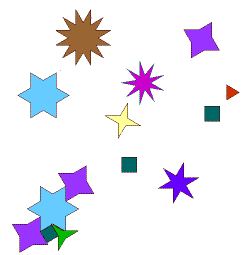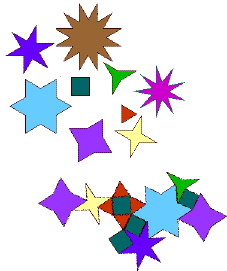Turning Manipulatives Inside
Out
By Gary
S. Stager
Dust Off Your Old Math Manipulatives
Tactile math manipulatives are a great tool for counting, measuring,
representing numerical relationships and exploring geometric
patterns. Logo provides an opportunity for manipulatives to be
used in new ways. While the following classroom activity appears
simple, it can yield quite complex mathematical thinking and
problem solving. Any manipulatives may be used including pattern
blocks, Cuisenaire Rods, Infix Cubes, tangrams and pentominoes.
Manipulatives which tessellate provide some of the richest opportunities
for problem solving. I am rather fond of the “Puzzelations,” foam-rubber
tessellating manipulatives, available from: http://www.tessellations.com/.
These manipulatives have a finite number of shape pieces which
may be combined in infinite ways.
The activity described below is appropriate for 4th grade through
adult learners. Past experience and mathematical knowledge may
be brought to the problem solving process, regardless of age.
Off-Computer Preparatory Activity
- Each group of 3-4 students should
be given a representative set of manipulatives with a few copies
of each piece.
- The same type of manipulatives
may be given to each student team or different sets may be
used, depending on the educational goals of the project.
- Students should spend some time
moving the pieces around and exploring their physical relationships.
- Decide upon names for each shape
(invented names are OK for strange pieces or with young learners)

Logo-based Activity
Teams of students will design “manipulative” software
to be used by others. The user should have a satisfying experience
manipulating the shapes on the screen.
Each team of students should pursue the following three goals:
- Create a Logo procedure to draw
each shape individually (polygons should all have equal sides)
- Write procedures to combine/connect
two or more of the pieces.
- Design an interface for a user
to manipulate the shapes on the screen and create interesting
patterns. Commands, buttons, sliders and text instructions
may be used to assist the user.

Extension Activities
- Use variables to control the
size of each piece.
- Use sliders to control the variable
size of each piece or even to zoom in/out of a tessellation.
- Use Find/Replace to replace
constant fd and bk distances with variables, such as: Replace FD with FD
Scale * . Be sure to do the same for BK and use :SCALE if
global variables are used instead of sliders.
- Write procedures to randomly
tessellate the pieces!
By using language to describe the attributes and
measurements of each piece students enhance their ability to understand
and communicate geometric relationships to the computer. Issues of
variable, measurement, angle and orientation are made concrete. Adults
who did well in high school math classes are often hamstrung by their
recollections of half-memorized algorithms while their colleagues
(or students) use their bodies, common sense and turtle geometry
to solve the same problems.
At the end of the activity, kids can trade software and explore the
work of their peers.
|



